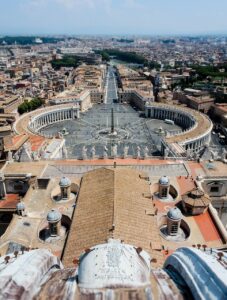

Arriving in Rome![]() is like arriving on a film set. An open-air set where every street, every alley, every monument recalls the world’s most famous films. Whether you have a day or a week, Rome will give you incredible emotions. Millennia of history can be breathed among the monuments located in every part of the city. From the centre to the Roman suburbs, everything oozes history, culture and why not, even nature.
is like arriving on a film set. An open-air set where every street, every alley, every monument recalls the world’s most famous films. Whether you have a day or a week, Rome will give you incredible emotions. Millennia of history can be breathed among the monuments located in every part of the city. From the centre to the Roman suburbs, everything oozes history, culture and why not, even nature.
Approximately 10 million people every year pass through the ruins of ancient Rome, admire Baroque Rome, the beauty of the Vatican***, the city’s historic quarters, Rione i Monti***, Trastevere***, Garbatella***, and the more recently built ones such as Eur***.
Historic Rome: Among the most visited monuments, with its 2,000 years of history, the Colosseum*** is still the symbol of the city.
Entering from Mount Palatine***, an entrance little known to most but which gives the possibility of avoiding the long queues at the central ticket office, one can walk through the millenary streets of one of the 7 Roman hills. Then down the street of the Roman Forum*** you will arrive directly at the Colosseum passing through the beautiful Arch of Constantine***. Then on to Via dei Fori Imperiali*** where an exceptional scenery opens up before those who walk along it: centuries-old columns and ruins of all kinds are capable of surprising even the most distracted tourists.
The Capitoline Museums***, the oldest in the world, are accessed via the Piazza del Campidoglio***, designed by Michelangelo and made even more majestic by the statue of Marcus Aurelius.
Descending from the Campidoglio via via del CorsoMaps-icon-small, you arrive at the baroque Piazza NavonaMaps-icon-small and then at the impressive Trevi FountainMaps-icon-small, where millions of tourists are enchanted every day by the beauty of the marble and the fascinating sound of the water. Impossible not to think of Marcello Mastroianni and Anita Ekberg in Fellini’s film ‘La dolce vita’.
And then again, leaving the beautiful fountain, you arrive at the Piazza di SpagnaMaps-icon-small with the majestic Spanish Steps (Francesco De Santis – 1700) and the Fontana della Barcaccia (Bernini – 1629).
Taking a stroll through the central streets of the city, crossing Piazza ColonnaMaps-icon-small, skirting the Parliament, and then going towards Palazzo Madama, where the Senate of the Republic is housed, one cannot miss a trip to the ancient café Sant’Eustachio, where the barmen manage to surprise all patrons with the taste and aroma of coffee garnished with sugar cream.
Christian Rome: On the other side of the Tiber River that splits the city in two, there is Castel Sant’AngeloMaps-icon-small, and Via della ConciliazioneMaps-icon-small, which leads the way to St. Peter’s BasilicaMaps-icon-small, where behind it, are the Vatican Museums with the famous and prestigious Sistine Chapel.
Church lovers are spoilt for choice. Rome, with 900 of them, is the city with the most churches in the world. Famous are the four papal basilicas: St Peter’s, St John LateranMaps-icon-small, St Mary MajorMaps-icon-small and St Paul’sMaps-icon-small. Don’t miss a visit to the Church of Santa Maria del Popolo in Piazza del PopoloMaps-icon-small and San Luigi dei Francesi near Piazza NavonaMaps-icon-small. Both churches have the distinction of housing some of Caravaggio’s most famous paintings. About 300 metres from Piazza Navona stands the building that has been the highest expression of Rome’s glory for more than two thousand years… the Pantheon***. Between the lively Piazza Navona and the aristocratic Piazza Farnese, lies one of the city’s many treasures, a place that, with its picturesque and characteristic market, represents the typical scenario of old Rome.
Campo de’ Fiori*** is one of the most distinctive and popular areas of the capital. It is the ideal setting for a pleasant stroll among its historic wooden stalls where you can buy flowers, fruit, meat and fish that are always fresh.
Campo de’ Fiori, however, also has a dark side: spectacular executions were held on the square, most notably that of the monk and philosopher Giordano Bruno who, accused of heresy, was burned at the stake here in 1600. An imposing and austere statue was erected in his honour in the centre of the square.
Certainly one of the most majestic monuments in the eternal city, the Altare della PatriaMaps-icon-small is located right in the heart of Rome. Also known as the ‘Vittoriano’, this mausoleum is an architectural complex of great proportions. The imposing monument was built as a historical testimony to the Unification of Italy and still stands today as an important symbol of Italian national identity.
Last but not least, an archaeological site of great interest are the Catacombs of the Appia Antica, the underground cemeteries of the early Christians located outside the city walls, in accordance with the ancient custom that forbade the burial of the dead in the city centre.
The archaeological site of Ostia AnticaMaps-icon-small with its excavations and the impressive castle of Pope Julius II deserves a separate visit.
Modern Rome: Leaving the city, a visit to the modern Eur quarter, wanted by Mussolini in the 1930s to host the famous Universal Exhibition of Rome in 1942, is a must. In addition to the many green parks and famous monuments of rationalist architecture, such as the Palazzo della Civiltà del Lavoro (better known as the Square Coliseum), Eur is home to some of the city’s most interesting museums, such as the Museo Nazionale Preistorico Etnografico Luigi Pigorini![]() and the Museo della Civiltà Romana
and the Museo della Civiltà Romana![]() .
.
Fashionable Rome: When it comes to fashion, glamour and events, Rome has nothing to envy of Milan. The shopping streets (Via del Corso, Via dei Condotti, Via Frattina and Via Borgnognona) are home to exceptional brands.
Continue
